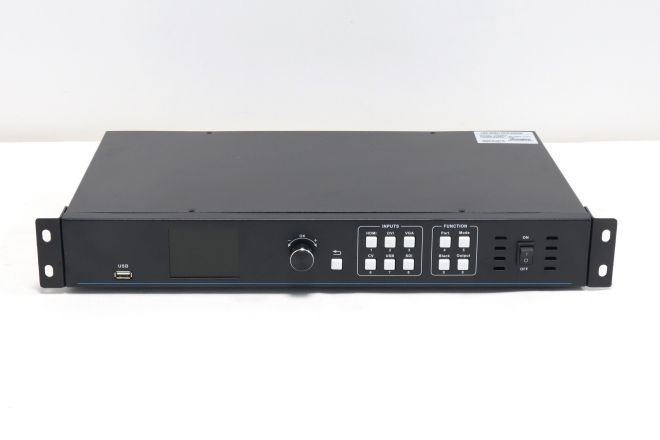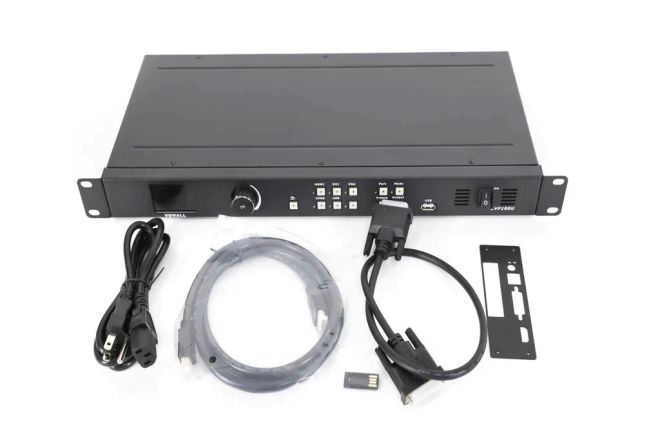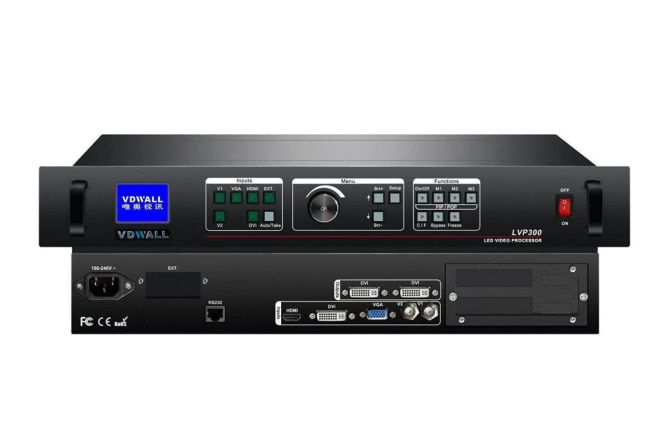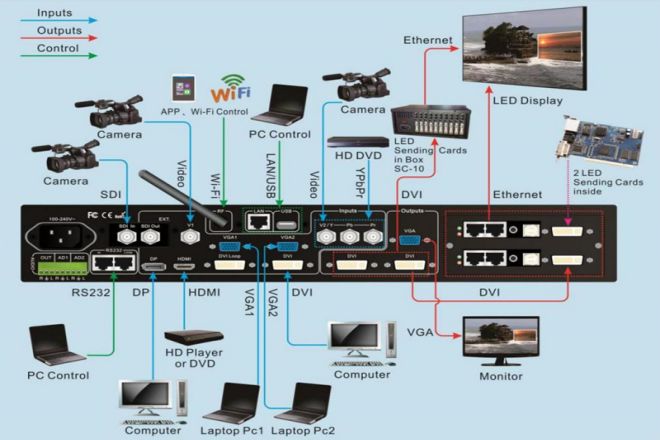소개

LED 디스플레이의 광범위한 적용으로 고품질 비디오나 사진을 재생하는 방법이 핵심 문제가 되었습니다. 답은 LED 디스플레이의 비디오 프로세서에 있습니다. 이 장치는 모든 것에 필수적입니다. LED 디스플레이.
그렇다면 LED 디스플레이 화면의 비디오 프로세서를 올바르게 사용하는 방법은 무엇일까요? 이것이 이 글의 핵심 내용입니다. 살펴보겠습니다.
1. LED 디스플레이 비디오 프로세서 소개
LED 디스플레이 비디오 프로세서, 영상 프로세서, 영상 변환기, 비디오 컨트롤러 또는 이미지 프로세서라고도 불리며, 풀 컬러 LED 디스플레이를 위해 특별히 설계된 고성능 이미지 처리 및 제어 장치입니다.
컴퓨터, TV, 플레이어 및 기타 장치의 비디오 신호를 LED 디스플레이가 인식할 수 있는 신호로 변환하여 "소통"을 돕는 번역기와 같은 역할을 합니다.
LED 디스플레이 비디오 프로세서의 주요 기능은 외부 장치(예: 블루레이 DVD, 컴퓨터, 고화질 재생 상자 등)의 이미지 신호를 LED 디스플레이가 수용할 수 있는 신호로 변환하고 비디오 이미지의 특정 최적화 처리를 수행하는 것입니다. LED 화면에 표시되는 그림을 더 선명하고 매끄럽게 만듭니다.
신호를 변환하는 것 외에도 비디오의 밝기, 색상 등을 조정하여 사진을 더 편안하게 보이게 할 수 있습니다. 비디오 크기가 LED 디스플레이와 일치하지 않으면 비디오를 확대하거나 축소하여 전체 화면에 비디오 콘텐츠를 표시할 수도 있습니다.
LED 디스플레이의 디스플레이 모드는 지점간이므로, LED 디스플레이는 자체의 물리적 해상도 크기와 일치하는 이미지만 표시할 수 있습니다.
LED 디스플레이는 색상 범위가 넓은 반면, 많은 비디오는 색상 범위가 좁기 때문에 비디오 프로세서도 색상을 조정하여 LED 디스플레이가 비디오의 실제 색상을 표시할 수 있도록 해야 합니다.
2. LED 디스플레이 비디오 프로세서의 작동 원리

LED 디스플레이 비디오 프로세서의 작동 원리는 다음 단계로 간략하게 요약할 수 있습니다.
- 신호 수신:
비디오 프로세서는 먼저 다양한 신호 소스(예: 컴퓨터, TV, 플레이어 등)로부터 비디오 신호를 수신합니다.
- 해상도 변환:
LED 디스플레이의 모듈식 디스플레이 특성으로 인해 해상도는 매우 유연할 수 있지만 비디오 신호의 해상도는 다양할 수 있습니다. 비디오 프로세서의 중요한 작업은 이러한 다양한 해상도의 비디오 신호를 LED 디스플레이에 허용되는 물리적 해상도로 변환하는 것입니다.
일반적으로 이는 이미지 크기를 조정하여 해상도를 높이거나 낮추어 전체 이미지가 LED 디스플레이에 표시되도록 하는 작업입니다.
- 색상 공간 변환:
LED 디스플레이의 색 영역(즉, 표시할 수 있는 색상 범위)은 일반적으로 일반 비디오 신호보다 넓습니다. 따라서 비디오 프로세서도 비디오 신호의 색 공간을 LED 디스플레이가 정확하게 표시할 수 있는 색 공간으로 변환하여 색상의 정확성과 선명도를 보장해야 합니다.
- 이미지 최적화:
비디오 프로세서는 또한 이미지의 품질과 시각적 효과를 더욱 개선하기 위해 대비 증가, 밝기 조정, 색상 향상 등 이미지에 대한 일련의 최적화 프로세스를 수행합니다.
- 출력 디스플레이:
위의 처리 과정을 거친 후, 비디오 프로세서는 최적화된 비디오 신호를 LED 디스플레이에 출력하고, LED 디스플레이는 비디오 신호를 광 신호로 변환하여 디스플레이한다.
3. LED 디스플레이 비디오 프로세서의 특징
LED 디스플레이 비디오 프로세서는 여러 가지 특수 기능을 가지고 있어 다양한 상황에서 유용합니다.
- 그림 크기 조절:
LED 디스플레이의 디스플레이 모드는 포인트 투 포인트이므로 자체 물리적 해상도 크기에 일치하는 그림만 표시할 수 있습니다. 그러나 비디오 프로세서는 이미지를 확장하고 그림을 모든 크기로 출력하여 다른 해상도의 LED 디스플레이에 적응할 수 있습니다.
때때로, 우리의 비디오 크기는 LED 디스플레이의 크기와 다를 수 있습니다. 이때 비디오 프로세서는 이미지를 확대하거나 축소하여 화면에 바로 표시할 수 있습니다.
- 신호 변환 및 스위칭:
비디오 프로세서는 HDMI, VGA, DVI 등 다양한 신호 간의 포맷 변환을 완료할 수 있습니다. 또한, 여러 신호가 연결된 경우 비디오 프로세서는 신호를 빠르게 유연하게 전환하여 디스플레이 콘텐츠를 더욱 다양하게 만들 수 있습니다.
예를 들어, 때때로 우리는 컴퓨터, 휴대전화 또는 TV를 사용하여 디스플레이 화면을 연결하고, 그들의 신호가 다를 수 있습니다. 비디오 프로세서는 이러한 다른 신호를 LED 디스플레이가 이해할 수 있는 신호로 변환하여 화면에 정상적으로 표시될 수 있도록 할 수 있습니다.
- 이미지 품질 개선:
비디오 프로세서는 디인터레이싱, 엣지 샤프닝, 모션 보상 등과 같은 고급 알고리즘을 사용하여 이미지 품질을 수정하여 이미지 세부 정보를 향상시키고 화질을 개선할 수 있습니다. 이는 LED 디스플레이에 특히 중요한데, 픽셀 간격이 종종 크기 때문에 흐릿하거나 왜곡된 이미지가 쉽게 발생할 수 있기 때문입니다.
- 대형 화면 스플라이싱:
LED 디스플레이의 크기가 점점 더 커짐에 따라 비디오 프로세서는 대형 해상도 화면을 구동할 수 있는 스플라이싱 기능을 가져야 합니다. 이를 통해 초대형 화면 디스플레이가 가능할 뿐만 아니라 디스플레이 효과와 비용 성능도 향상됩니다.
- 다중 사진 처리:
빌보드, 회의실 등과 같은 일부 특수 시나리오에서 디스플레이 화면은 동일하거나 다른 신호의 여러 그림을 동시에 표시해야 할 수 있습니다. 비디오 프로세서의 다중 그림 처리 기능은 이러한 요구 사항을 충족하여 여러 그림을 동시에 LED 디스플레이 화면에 명확하게 표시할 수 있습니다.
예를 들어, 대형 LED 디스플레이가 있는 경우 비디오 프로세서는 여러 개의 작은 화면을 하나의 큰 화면으로 통합하여 더 큰 그림을 표시할 수 있도록 도울 수도 있습니다. 게다가 여러 이미지를 동시에 표시할 수 있는데, 예를 들어 빌보드에 여러 개의 다른 광고를 재생하는 것과 같습니다.
- 대화형 기술:
일부 고급 LED 스크린 스캐닝 기계는 맞춤형 터치 스크린, 클라우드 기술 방송 제어 관리 등의 대화형 기술을 사용하여 광고 매체와 광고 대상 청중 간의 상호 작용을 강화합니다.

4. LED 디스플레이 비디오 프로세서의 핵심 기술
LED 디스플레이 비디오 프로세서의 핵심 기술은 주로 다음과 같은 측면을 포함합니다.
- 고정밀 풀 그레이스케일 밝기 및 색도 보정 기술:
이 기술은 LED 디스플레이가 다양한 환경에서 정확한 색상과 밝기를 표현할 수 있도록 보장합니다. 실내든 실외든, 강한 빛이든 어두운 빛이든, LED 디스플레이는 이 기술을 통해 색상 정확도와 밝기 적합성을 유지할 수 있습니다.
- Fine-pitch LED 디스플레이 화질 엔진 기술:
미세 피치 LED 디스플레이는 픽셀 피치가 작기 때문에 이미지 품질에 대한 요구 사항이 더 높습니다. 이 기술은 미세 피치 LED 디스플레이의 이미지 품질을 크게 개선하여 이미지를 더 섬세하고 선명하게 만들 수 있습니다.
- 고동기화 영상처리 기술:
이 기술은 다중 계층 및 다중 화면 관리를 지원하여 여러 화면 간에 콘텐츠를 동기적으로 표시할 수 있습니다. 대형 빌보드이든 회의실의 다중 화면 스플라이싱이든 이 기술은 각 화면에 표시되는 콘텐츠의 동기화 및 일관성을 보장할 수 있습니다.
- 지능형 이미지 컬러 처리 및 초고해상도 재구성 기술:
이 기술은 인간의 눈의 시각적 특성에 부합하며 이미지 색상을 더욱 사실적이고 자연스럽게 만들 수 있습니다. 동시에 초고해상도 재구성 기술을 통해 이미지의 해상도를 향상시켜 그림을 더욱 선명하게 만들 수도 있습니다.
- 디스플레이 클러스터를 위한 고정밀 지능형 오류 식별 기술:
이 기술은 디스플레이 오류를 빠르고 정확하게 식별하고 수리하여 LED 디스플레이의 안정성과 신뢰성을 보장합니다. 데드 픽셀, 밝은 선 또는 색상 왜곡과 같은 문제가 있든 이 기술은 이를 적시에 감지하고 처리하여 디스플레이의 정상적인 작동을 보장합니다.
5. 어떻게 사용하나요?

장치를 연결합니다: 먼저, 다양한 신호 소스(예: 컴퓨터, TV, 플레이어 등)를 적절한 인터페이스를 통해 LED 비디오 프로세서에 연결합니다. 모든 인터페이스가 올바르게 연결되었고 장치가 신호를 올바르게 전송하는지 확인합니다.
입력 설정: 비디오 프로세서에서 입력 소스를 설정해야 합니다. 여기에는 일반적으로 올바른 입력 인터페이스와 신호 형식을 선택하는 것이 포함됩니다. 소스와 일치하는 입력 설정을 선택해야 합니다.
디스플레이 매개변수 조정: LED 디스플레이의 구체적인 사양 및 요구 사항에 따라 해상도, 재생 빈도, 밝기, 대비 등과 같은 디스플레이 매개변수를 조정합니다. 이러한 매개변수의 설정은 디스플레이의 디스플레이 효과에 영향을 미칩니다.
다중 사진 처리: 여러 장의 사진을 동시에 표시해야 하는 경우 비디오 프로세서의 다중 사진 처리 기능을 사용할 수 있습니다. 이는 일반적으로 화면에 여러 입력 신호를 동시에 표시하고 위치와 크기를 조정하는 것을 포함합니다.
색상 보정: 보다 정확한 색상 표시를 위해 비디오 프로세서의 색상 보정 기능을 사용할 수 있습니다. 이는 일반적으로 색상 정확도와 일관성을 보장하기 위해 RGB 색상 채널의 값을 조정하는 것을 포함합니다.
시작 및 디버깅: 위의 설정을 완료한 후 비디오 프로세서를 시작하고 디스플레이의 디스플레이 효과를 관찰합니다. 필요한 경우 추가 디버깅 및 최적화를 수행하여 최상의 디스플레이 효과를 얻을 수 있습니다.
6. LED 디스플레이 비디오 프로세서 브랜드 선택에 관하여
LED 디스플레이 프로세서 브랜드 중에서 가장 좋은 것은 물론 Nova 프로세서입니다.
물론 RGBSKY, Linsn Technology, KYSTAR, AVSOLUTIOMYECH 브랜드도 비디오 프로세서 제품으로 알려져 있으며, 각각 고유한 특성과 장점을 갖고 있습니다.
따라서 필요한 기능을 갖춘 비디오 프로세서를 선택할 때 애플리케이션 요구 사항을 고려해야 합니다. 예를 들어, 고화질 비디오 신호를 처리해야 하는 경우 고화질 입출력을 지원하는 비디오 프로세서를 선택해야 합니다.
또한, 브랜드의 애프터서비스 보증도 매우 중요한데, 이는 앞으로 불필요한 문제를 많이 예방하는 데 도움이 됩니다.
결론
위의 내용은 LED 디스플레이 비디오 프로세서에 대한 모든 지식입니다. LED 디스플레이에 대해 더 알고 싶다면, 우리에게 연락해주세요!
